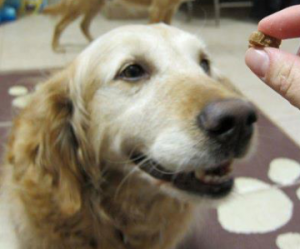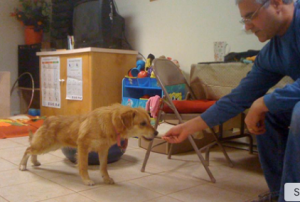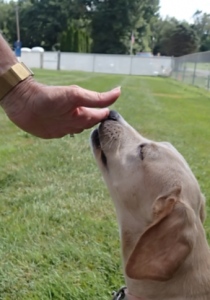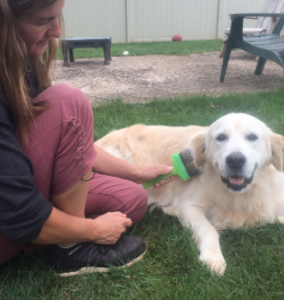 High-Value Treats!
High-Value Treats!
Kibble is good for a meal, but for training, we need something tasty and irresistible that will allow your dog to choose to come back over and over for more. Here are some of the food choices we use as high-value treats in PHL: hot dogs, chicken, meatballs, steak, peanut butter, cheese, and squeeze cheese. Many of these items can be cut into small pieces and even warmed up to tempt your dog’s sense of smell. Remember, a large quantity of little bits of high-value food is more rewarding than one big bite. Therefore, break up the hot dogs or meatballs into small pieces.
![]()
 Treat Retreat
Treat Retreat
When we were kids, we all learned not to take candy from strangers, yet that is exactly what we are trying to get human-fearful dogs to do when we try to coax them to us with a treat. One less scary method to teach dogs to come to us is called “Treat Retreat.” The dog gets two rewards: to move away from a potentially threatening person (in their mind) and the treat. It might seem counterintuitive, but to teach a dog that we are not a threat to them, we toss the treat away from us. Before you start, you need to be sure the dog will eat in your presence; it won’t work if they won’t eat.
Here’s how to do it: Sit on the floor or in a chair with a bag of yummy treats. The fearful dog will show you the distance at which they are comfortable being near you. Let’s say it’s eight feet away; gently toss a treat to land a couple more feet behind the dog. Try not to do a big overhand toss that might scare them. They will get the treat and get to move farther away from you, the perceived scary person. You’ll find dogs will tend to look at you after they eat the treat, so now is the time to toss the next one. Slowly they’ll start to think, “Hey, maybe they aren’t so bad after all. They aren’t trying to trick me into something.” After each toss, the dog may even start moving closer and closer to you. This is the goal. If they don’t approach closer in one session, that’s okay; you can try again another time. Once they know the Treat Retreat game, it can be useful to introduce the dog to new people. The people may be new, but the game is the same.
![]()
 Follow Me
Follow Me
These dogs are not like “normal” dogs that will automatically come to you when you call their name. In fact, many are scared of coming toward people! For this reason, we teach them to “follow” us. This is a good activity to learn so you can teach them to follow you in through doorways and other areas. First, keep it casual in your house or out in your fenced yard and simply pat your leg, say “follow me,” and walk away from the dog. If they don’t catch on and need more motivation, drop high-value treats behind you as you walk away. Having their mentor dog(s) follow you around is also a great motivator! Remember, your own body language can have a big impact on how a dog responds to you. Walking away from a dog and getting them to follow you may be more comfortable for a scared dog instead of you trying to approach them.
![]()
 Hand Targeting aka “Touch”
Hand Targeting aka “Touch”
Teaching the activity “touch” (or target) is very useful when rehabilitating shy dogs. Many shy or fearful dogs are, at first, afraid of human hands. Were they roughly handled? Were their collars grabbed every time a hand approached? Are they sensitive to being touched? Our goal is to change their perception of human hands from negative to positive.
Situations to use “touch”:
• When greeting new people (Saying, “Hi!”)
• When teaching “Come” (Recall)
• When experiencing a new object
• To redirect your dog’s attention
Teaching basic “touch”:
• Put a small treat in between your fingers or rub your hand with a food that smells delicious to your dog.
• Hold your hand with your palm facing out and say, “Touch!” If the dog seems afraid of your open palm, try either the back of your hand or a closed fist.
• Wait for your dog to put their nose to your hand looking for the treat. Say, “Yes!” and reward with a treat from your opposite hand (not the hand the dog is touching). Even if they touch your hand by accident, it still counts! At first, if they won’t actually make contact, reward getting close, then slowly work up to closer and closer.
• Once your dog is reliably touching their nose to your hand about 80 percent of the time, you can start moving your hand higher or lower as well as using the opposite hand. Then have different people try the activity.
• You can then have the dog target objects with their nose such as a brush, the dog bowl, or other objects that they may need reassurance to not be a threat.
![]()
 Petting & Brushing
Petting & Brushing
Some dogs are very fearful to being touched while others can’t get enough petting and affection. For those that are fearful, you may choose to work on other activities first that do not involve touching the dog such as Treat Retreat, Follow Me, and hand targeting until the dog is choosing to approach you.
Petting and brushing help build the bond between you and your dog and help to acclimate them to your touch. It’s hard to imagine a dog not wanting to be stroked and petted, but for some, it is an experience they must learn to enjoy.
For petting, start by sitting next to the dog, not face-to-face, which can be intimidating. Make sure the dog is not cornered or does not feel cornered; ensure the dog always has an escape path. If your dog is lying next to a wall and you approach to pet them, make sure your dog has a visible space to escape. If not, they may experience a feeling of being trapped. We want these activities to be positive experiences. The dog may not use the escape route, but at least they will know there is a way out if they become too uncomfortable. This is another reason to sit alongside your dog rather than face-to-face.
Pet under the dog’s neck, behind the ears, or stroke lightly across the dog’s back to begin. Avoid touching the dog’s tail or paws, which are sensitive body parts and may elicit a negative reaction. Also avoid tapping or patting heavily on top of their head. Never put your face in the dog’s face.
For brushing, start by using a soft bristle brush or a “glove” brush. Brush with gentle strokes across the dog’s back or on the chest area if they’re sitting. If your dog seems to easily tolerate the glove or soft bristle brush, you may advance to a pin brush or rake brush.
Once your dog starts to enjoy brushing, you should begin to brush and pet other areas as well. Eventually, you should start working on gently touching their paws, but please only begin this once they’re comfortable being petted in most other areas. One way to assess if the dog enjoys being brushed is to stop. If they look at you for more or move closer, they are probably enjoying it. If they freeze or move away, they are probably not enjoying it.
With this activity and all activities suggested, keep your sessions short. For example, pet and brush your dog for about five minutes. Then walk away and give them time out of the “pressure zone.”
On the same note, when choosing a groomer for your dog, make sure the groomer understands shy dog behavior and will be gentle and help the dog the best they can. Even better, if the groomer will allow you to stay during the grooming session, this may be comforting to your dog.

